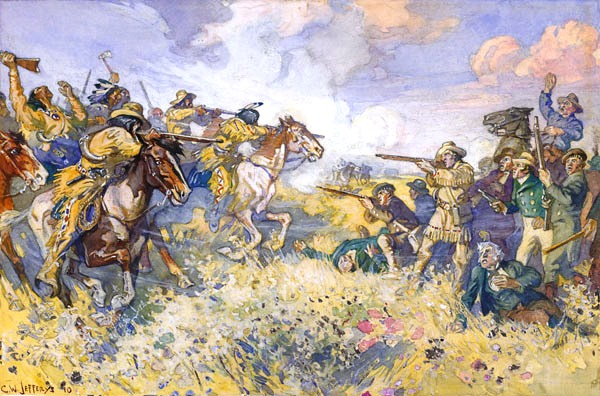
By 1816, the United States was developing policies that would remove all Indians from the eastern portion of the country and resettle them in lands located west of the Mississippi River. Under the vision of Manifest Destiny, the United States saw itself expanding its great land empire to the west and aiding the extinction of American Indians.
Listed below are a few of the American Indian events of 1816.
Manifest Destiny
John Melish finished his Map of the United States which was considered to be a cartographic masterpiece. The map showed the full continent. He says of his map:
“The map so constructed shows at a glance the whole extent of the United States territory from sea to sea; and in tracing the probable expansion of the human race from east to west, the mind finds an agreeable resting place, at its western limits.”
In Illinois, a troop of American soldiers constructed Fort Armstrong atop a limestone cliff above the Mississippi River. The new fort was located on Rock Island, about four miles from the Sauk village of Saukenuk. In his book Black Hawk: The Battle for the Heart of America, historian Kerry Trask writes:
“Rock Island was regarded as a very special pace that was under the care of a ‘Good Spirit,’ who lived in a cave directly below the site the soldiers had chosen for their fort.”
Indian Removal
President James Monroe approved a plan to move New York Indians to the west.
In Ohio, the Iroquois Six Nations met with the Shawnee, Ottawa, and Wyandot to discuss the possibility of the removal of the New York tribes to Ohio. Mohawk leader Joseph Brant felt that it would be a good idea for the Seneca to move to Sandusky where they could join with the Wyandot. Arthur Caswell Parker. In his biography Red Jacket: Seneca Chief, describes the council:
“The chiefs of the Six Nations, long accustomed to the clothing of the white man, were once more dressed in their ancient costumes.”
Seneca leader Red Jacket addressed the council and reminded them that those tribes who recently sided with the British had lost a great deal. Red Jacket told them:
“We have always lost by taking up the hatchet. Even the British, upon whom we pinned our hopes, sold our land to the Americans after every war in which we were allied with them.”
Red Jacket spoke against selling land to the Americans:
“To command respect, you must possess extensive territory! Keep your holdings sufficiently large so that you may not be crowded on any side by the whites.”
Conflicts and Wars
About 6,000 Cherokees had moved from their traditional homelands in the southeast into the traditional hunting area of the Osage on the Great Plains. According to historian Willard Rollings, in his book The Osage: An Ethnohistorical Study of Hegemony on the Prairie-Plains:
“These Cherokee invaders of Osage country were well armed and skilled hunters. When Cherokee and Osage met on hunting expeditions, violence ensues as both groups struggled for control of the territory.”
While the Osage allowed payment to “to cover the dead” in place of blood revenge, Cherokee traditions required blood revenge when a Cherokee was killed by a non-Cherokee.
The Americans arranged for peace negotiations between the two nations and an agreement was signed by which the Osage gave up their claim to much of the Cherokee country in western Arkansas and northeastern Oklahoma. The agreement, however, was not ratified by the Senate.
In Illinois, Kickapoo leader Little Otter sent messages to the Potawatomi, Miami, and other tribes asking them to join the Kickapoo in making war against the Americans. The other tribes, fearful of American reprisals, publically refused the Kickapoo war belts and boycotted the council which Little Otter attempted to hold. In The Kickapoos: Lords of the Middle Border, A.M. Gibson reports:
“Unable to win followers in their anti-American crusade, the Kickapoos began their own campaign against the Long Knife intruders. Cattle and horses were stolen, settlers’ homes were looted, and haystacks and barns were burned by fast-riding Kickapoo raiders.”
In Florida, American soldiers together with 200 Creek warriors under Chief William McIntosh invaded Spanish territory in an attempt to capture blacks who were living among the Seminole. The 300 Seminoles – including 30 Seminole men and 70 black men – took refuge in Fort Apalachicola. The fort was then blown up by the Americans, killing 270 people. The survivors were taken to Georgia where they were enslaved. In revenge, other Seminoles began a campaign of attacking American settlements along the Georgia-Florida border.
In Oklahoma, the Indian agent for the Caddo, with the help of a military detachment, removed about a dozen American families from an unauthorized settlement on Pecan Point. Several unlicensed traders were arrested and their merchandise was seized.
In Wyoming, a war party of Assiniboines attempted to capture Crow horses. Thirty Assiniboine were killed.
In Texas, the Comanches made a truce with the Lipan Apache under El Cojo. This ended 60 years of warfare between the two groups. In his book The Comanche Empire, historian Pekka Hamalainen reports:
“With the truce, El Cojo’s Lipans won hunting privileges in southern Comanchería and in return opened their territories to Comanches, who swiftly extended their stock and slave raids to the lower Río Grande valley and its many villages and haciendas.”
The Comanche raiding parties were often aided by Lipan Apache guides.
In South Dakota, Sioux leader Red Thunder had a violent confrontation with an unidentified Yanktonai man and was wounded in the head. Following this he formed his own band which was then called the Cutheads.
Smallpox
In Texas, smallpox struck the Caddo, Wichita, Comanche, Kiowa, and Kiowa-Apache. Among the Comanche, 4,000 died.
In New Mexico, the Pueblo of San Juan was afflicted by a smallpox epidemic.
Museum
In St. Louis, Missouri, William Clark established the first museum west of the Mississippi when he added a room to his house. The room served as a museum for his collection of Indian artifacts as well as a council chamber for meeting with delegations of visiting Indians.
Refugees
Following the 1812 war with the British, many of the Indian allies of the British were refugees in Canada. By 1816, some of these Indians began to return to the United States.
Shawnee prophet Tenskwatawa, who was living in exile in Canada, contacted the Americans and asked to be allowed to establish a temporary village south of Detroit along the River Raisin. The Americans, however, had no intention of allowing Tenskwatawa to establish a separate village and his request was denied.
In Michigan, many Indians who were loyal to the Shawnee prophet Tenskwatawa returned from Canada to the United States. They encountered a British soldier whom they believed to be a deserter. Tenskwatawa had the man seized and taken back to Canada. The soldier, however, was not a deserter, but had been sent to the United States on legitimate business. As a result, the Americans charged Tenskwatawa with kidnapping and issued a warrant for his arrest. If he returned, he was to be arrested.
In preparation for Tenskwatawa’s return, his followers established a small village near the mouth of the Tippecanoe River in Indiana. When it was apparent that he was not returning, most of his followers left. Soon the village was reduced to 27 people, most of whom were his relatives, including Tecumseh’s son.
Court Ruling
In Massachusetts, the state supreme court in Andover vs Canton declared Indians “the unfortunate children of the public, entitled to protection and support.”
Prominent Deaths
In Maine, Molly Ockett fell ill and died at about 80 years of age. She was considered to be the “Last Pigwacket.”
In Wisconsin, Winnebago chief Spoon Decora died at the age of 86. His son Waukon Decora became chief.
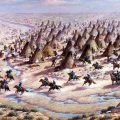
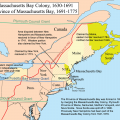
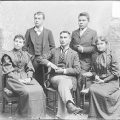
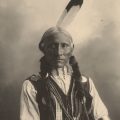
Leave a Reply